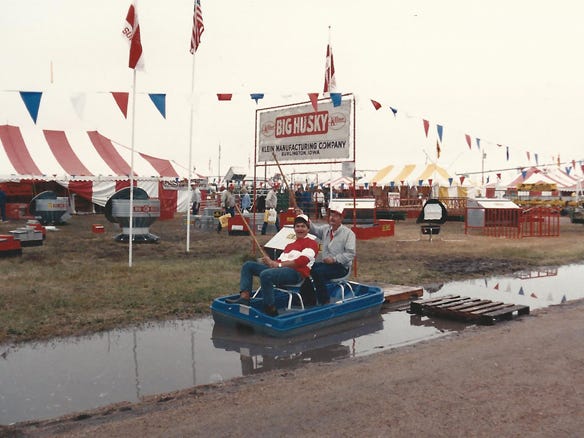
With $7.5 million in upgrades to the show site this year, it’s fair to say Husker Harvest Days is a completely new site. While these upgrades are certainly the biggest the site has seen since its original construction back in 1977, there have been a number of upgrades over the last 41 years at the site.
Don McCabe, former editor of Nebraska Farmer, was three months on the job when he went to the groundbreaking of what would become the show site in October 1977.
“When they broke ground, it had been a nice, flat pasture. It was leased by the U.S. Army to a cattle producer,” McCabe recalls. “You wouldn’t think they needed to, but the site needed to be leveled, primarily for gated pipe irrigation. Center pivots came later. There was an open ditch system at first.”
Originally the Cornhusker Ammunition Plant, the site had been leased as pastureland, and a number of infrastructure improvements were needed to get the ball rolling. This took the help of exhibitors: The pasture had to be converted and leveled for gravity irrigation. Wells needed to be drilled; irrigation systems installed.
Early on, there were few permanent buildings on-site. “If you went there in early September, there were people working on lots, but nobody was there doing landscaping the weekend before the show. Then you came back, and a city popped up — made of tents,” McCabe says. “Now, you drive out there, and you know you’re at a show site even in the off-season.”
Over time, notes Suzy Kleeb, office manager at HHD, exhibitors have invested more in permanent buildings. "As equipment companies have merged, lots have gotten bigger, because the equipment has gotten a lot larger,” Kleeb says. "The site itself has grown, and in the early stages, the early years, it was just a few buildings, compared to now. Many of the exhibitors have a permanent structure on-site. Permanent exhibits have invested a lot in sprinkler systems and landscaping."
As equipment got bigger, streets and lots needed to get bigger to accommodate them. Lots also got bigger as companies merged — although they often stayed close by. “The biggest change in the show in general is how big equipment got. Companies had to expand from one to two lots,” says Terry Butzirus, regional sales manager at Farm Progress. “For years, we didn’t use the south two or three streets. The first major merger, when Massey was bought by Agco, we didn’t think we would fill the show site.”
And, a few locations at the show site have moved over the years. The show office — now located on the southwest side of the show site — used to be on the corner of Central Avenue and Main Street, right across the street from where the Hospitality Tent is now.
As technology has changed, different structures have come and gone, including phone banks, which were a key fixture at HHD for several years. "We had telephone banks on some of the corners of major intersections, and there was a main phone bank located near the office when it was on the corner of Central and Main. Exhibitors would stand in line to call into their companies, usually the first thing in the morning, because there were no cellphones,” Kleeb says. "Now, we have cellphone towers, and they bring in transportable units for cell reception during the show."

OUTDATED TECH: Before cellphones, phone banks could be found on several intersections at the show.

Since the beginning, one of the things people remember most about Husker Harvest Days is the years it rained and the years it didn’t rain. “Dusty and/or wet streets are nothing new,” McCabe says. “People got the impression it was always windy, dusty or wet.”
Butzirus notes 1982 and 1987 were two particularly wet years. And one of the biggest changes over the years has been to the streets and drainage to accommodate those wet years, he says. “At first, the roads were all flat, and there was no drainage. When we got too much rain, we had two Snyder tanks on a trailer, we would go to where the biggest puddle was, pump it into the Snyder tanks and go drain them,” Butzirus says. “We would stay at the show site until 2 or 3 in the morning doing that.”

WATERLOGGED: Before the show made its many upgrades to drainage, attendees developed a good sense of humor when dealing with rain.

“They peaked the streets after the 1982 show, so water wouldn’t pool in the middle, but sometimes you had to long-jump across a ditch to get to an exhibit,” McCabe says.
Of course, some of the biggest upgrades to the show site came over the last year. This year, lot numbers have changed, and with the exception of Main Street and Central Avenue, street numbers have flipped. All 5.5 miles of the streets in the exhibit area have been paved and have storm drains in the center to improve drainage — so no more puddles to jump over.
The HHD show site has seen plenty of changes over the last 41 years, and these latest upgrades promise to bring it back to the premiere site it was when the show first started in the late 1970s.
About the Author(s)
You May Also Like






